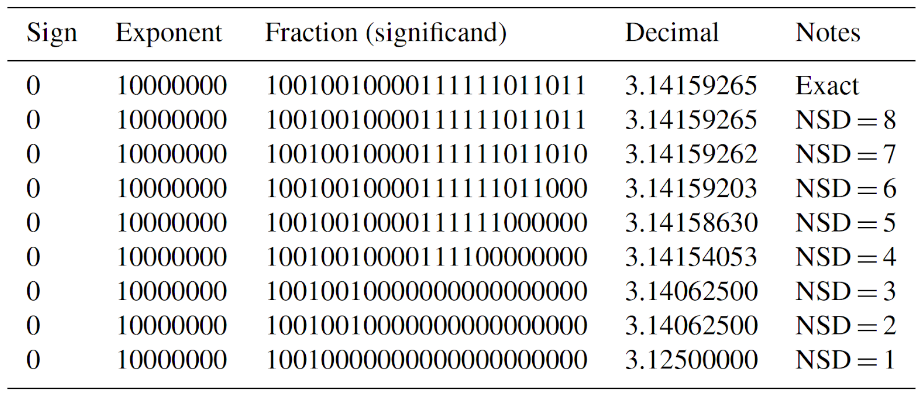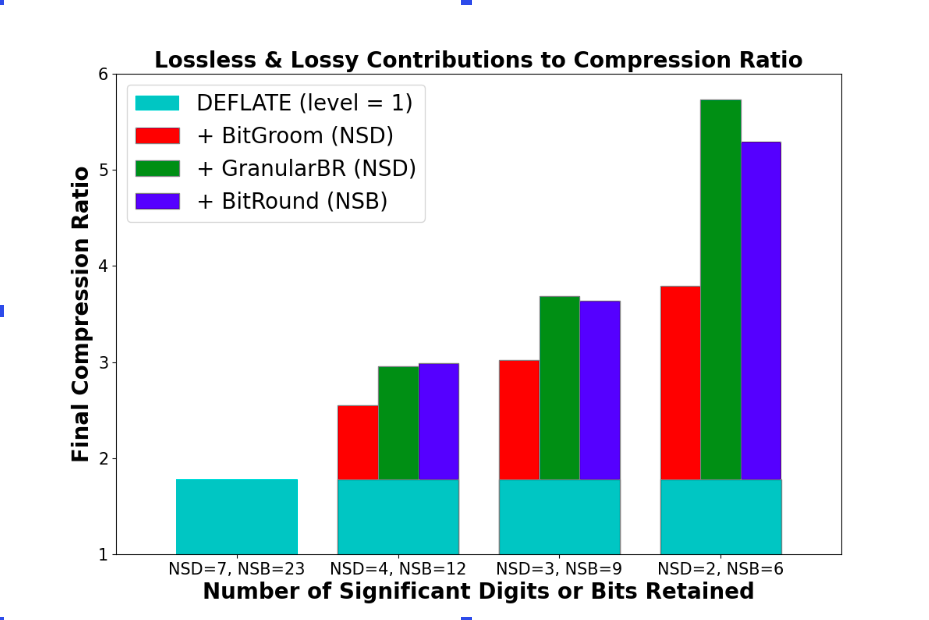 |
NetCDF
4.9.2
|
 |
NetCDF
4.9.2
|
The quantize feature was initially developed as part of the Community Codec Repository (CCR) [2]. The CCR project allows netCDF users to make use of HDF5 plugins (a.k.a. “filters”) which can add new compression and other algorithms to the HDF5 library. As part of CCR, the quantization algorithms were implemented as HDF5 filters.
However, one aspect of implementing the quantization as a filter is that the filter is also required when reading the data [1]. Although this makes sense for compression/decompression algorithms, the quantize algorithms are only needed when data are written. Requiring that the readers of the data also install the filters places an unnecessary burden on data readers. Furthermore, using the quantize filter results in data that cannot be read by netCDF-Java or versions of netcdf-c before 4.8.0, when support for multiple HDF5 filters was added. For these reasons, it was decided to merge the quantize algorithms into the netcdf-c library [5].
As part of the netcdf-c library, the quantize algorithms are available for netCDF/HDF5 files, and the new ncZarr format, and produce data files that are fully backward compatible for all versions of netcdf-c since 4.0, and also fully compatible with netcdf-Java.
The quantize algorithms assist with lossy compression by setting excess bits to all zeros or all ones (in alternate array values). This allows a subsequent compression algorithm, like the zlib-based deflation built into netCDF-4, to better compress the data.
The quantize feature is applied to a variable in a netCDF file, and may only be used with single or double precision floating point (netCDF types NC_FLOAT and NC_DOUBLE). Attempting to turn on quantize for any other type of netCDF variable will result in an error.
It should be noted that turning on quantize does not, by itself, reduce the size of the data. Only if subsequent compression is used will setting the quantize feature result in additional compression.
 Figure 1: The value of Pi expressed as a 32-bit floating point number, with different levels of quantization applied, from Number of Significant Digits equal to 8 (no quantization), to 1 (maximum quantization). The least significant bits of the significand are replaced with zeros, to the extent possible, while preserving the desired number of significant digits. In this example the Bit Grooming quantization algorithm is used.
Figure 1: The value of Pi expressed as a 32-bit floating point number, with different levels of quantization applied, from Number of Significant Digits equal to 8 (no quantization), to 1 (maximum quantization). The least significant bits of the significand are replaced with zeros, to the extent possible, while preserving the desired number of significant digits. In this example the Bit Grooming quantization algorithm is used.
Three different quantization algorithms are provided in the netcdf-c quantize feature. Each does a somewhat different calculation to determine the number of bits that can be set to zeros (or ones), while preserving the number of significant digits specified by the user.
Two of the algorithms, Bit-Groom and Granular Bit-Round, accept the number of decimal digits to be preserved in the data. One algorithm, Bit-Round, accepts the number of binary bits to preserve.
The Bit Grooming algorithm sets determines the number of bits which are necessary for the required number of significant decimal digits. This determination is made at the beginning of processing and is applied to all values.
Bit Grooming then sets excess bits of the first array value to zero, then excess bits of the next array value to one, and continues alternating between zero and one for the excess bits of every other array value. In this way, the average value of the array is preserved.
For the Bit Grooming algorithm, the NSD parameter refers to the number of significant decimal digits that will be preserved. The number of significant digits may be 1-7 for single precision floating point, or 1-15 for double precision floating point.
Granular Bit Round determines the number of required bits for each value in the array, and uses IEEE rounding to change the data value. It achieves a better overall compression ratio by more aggressively determining the minimum number of bits required to preserve the specified number of decimal digit precision.
For the Granular Bit Round algorithm, the NSD parameter refers to the number of significant decimal digits that will be preserved (as with the Bit Grooming algorithm). The number of significant digits may be 1-7 for single precision floating point, or 1-15 for double precision floating point.
The Bit Round algorithm allows the user to directly specify the number of bits of the significant which will be preserved, and then sets excess bits to zero or one for alternate array values.
For the Bit Round algorithm, the NSD parameter refers to the number of significant binary digits that will be preserved. The number of significant digits may be 1-23 for single precision floating point, or 1-52 for double precision floating point.
When the quantize feature is used, an integer attribute is added to the variable which contains the NSD setting. Without this attribute it would be impossible for readers to know that quantize had been applied to the data. The name of the attribute reflects the quantize algorithm used. In accordance with the conventions established by the NetCDF Users Guide, these attribute names begin with an underscore, indicating that they are added by the library and should not be modified or deleted by users [6].
| Algorithm | Attribute Name |
|---|---|
| Bit Groom | _QuantizeBitGroomNumberOfSignificantDigits |
| Granular Bit Round | _QuantizeGranularBitRoundNumberOfSignificantDigits |
| Bit Round | _QuantizeBitRoundNumberOfSignificantBits |
Figure 2: Table showing the names of the attribute added to a variable after the quantize feature has been applied. The name of the attribute indicates the algorithm used, the integer values represents the number of significant decimal digits (for Bit Groom and Granular Bit Round), or the number of significand bits retained (for Bit Round).
In a netCDF file, fill values refer to the value used for elements of the data not written by the user. For example, if a variable contains an array of 10 values, and the user only writes 8 of them, the other two values will be set to the fill value for that variable.
The fill value of a variable may be set by the user by adding an attribute of the same type as the variable with the name “_FillValue”. If present, the value of this attribute will be used as the fill value for that variable. If not specified, a default value for each type is used as the fill value. The default fill values may be found in the netcdf.h file.
When using the quantize feature, any fill values will remain unquantized. That is, the excess bits of any array element will not be changed, if that element is the fill value. This is necessary if the fill value is to retain its purpose as an indicator of values that have not been written.
Any lossy compression introduces distortions to data.
The Bitgroom algorithms implemented in netcdf-c introduce a distortoin that can be quantified in terms of a relative error. The magnitude of distortion introduced to every single value V is guaranteed to be within a certain fraction of V, expressed as 0.5 * V * 2**{-NSB}: i.e. it is 0.5V for NSB=0, 0.25V for NSB=1, 0.125V for NSB=2 etc.
Two quantize algorithms use different definitions of decimal precision, though both are guaranteed to reproduce NSD decimals when printed.
The margin for a relative error introduced by the methods are summarised in the table:
If one defines decimal precision as in BitGroom, i.e. the introduced relative error must not exceed half of the unit at the decimal place NSD in the worst-case scenario, the following values of NSB should be used for BitRound:
The resulting application of BitRound is as fast as BitGroom, and is free from artifacts in multipoint statistics introduced by BitGroom (see https://doi.org/10.5194/gmd-14-377-2021).
Turning on the quantize feature must be done on a per-variable basis, after the variable has been defined, and before nc_enddef() (or its Fortran equivalents) have been called. (Recall that for netCDF/HDF5 files, nc_enddef() is automatically called when data are written or read from a variable.)
In accordance with the usual NetCDF API practice, an inquiry function is also provided which may be called to check if quantize has been turned on for a variable. Calling the inquiry function is not required when reading the data - it is provided for user convenience.
Quantize is available in the main branch of the netcdf-c library, and will be part of the next release (netcdf-c-4.9.0).
To turn on the quantize feature, call the nc_def_var_quantize() function. To inquire about whether quantize been turned on for a variable, use the nc_inq_var_quantize() function.
Figure 3: Example of using the quantize feature in C. Note that the example also demonstrates adding zlib (a.k.a. deflate) compression to the variables. Without turning on the compression, use of quantize alone will not result in smaller data output.
Quantize is available on a branch of the netcdf-fortran libraries, and will be merged to main after the next netcdf-c release (4.9.0) and will be released as part of the netCDF Fortran 90 API in the subsequent release of netcdf-fortran.
In the Fortran 90 API, quantization is turned on by using two new optional arguments to nf90_def_var(), the quantize_mode and the nsd arguments.
Figure 4: In the Fortran 90 netCDF API, two additional optional parameters are available for the quantize feature, the quantize_mode and nsd parameters.
Quantize is available on a branch of the netcdf-fortran libraries, and will be merged to main after the next netcdf-c release (4.9.0) and will be released as part of the netCDF Fortran 77 API in the subsequent release of netcdf-fortran.
Figure 4: In the Fortran 77 netCDF API, nf_def_var_quantize() and nf_inq_var_quantize() are provided, which wrap the quantize functions from the C API.

Figure 5: Compression ratio of E3SM Atmosphere Model (EAM) v2 default monthly dataset of raw size 445 MB compressed with default netCDF lossless compression algorithm (DEFLATE, compression level=1) alone (leftmost), or after pre-filtering with one of three lossy codecs (BitGroom, Granular BitGroom, or BitRound) with quantization increasing (and precision decreasing) to the right.